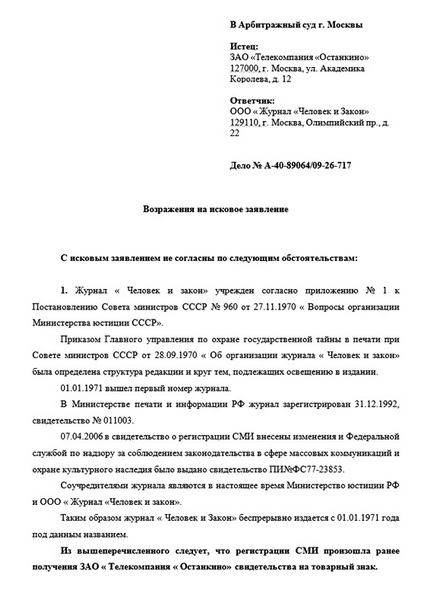Article 35, part 1 of the Code of Civil Procedure provides persons participating in civil proceedings with the right to file an objection to the statement of claim. In Art. 149, part 2, sub. 2 contains a direct indication of the possibility of exercising this right by the defendant and his representative at the preparatory stage of the process. Let us further consider how to file an objection to the statement of claim. A sample document will also be presented in the article. 
General information
The document, which acts as an objection to the statement of claim, has undergone some changes related to the introduction of a number of amendments to the legislative framework. The defendant may disagree on a number of points. In particular, they include the plaintiff's claims regarding legal, substantive claims, as well as the procedural aspects of the proceedings.
Important point
If the defendant (third party) expresses a neutral position on the requirements presented, then a review is drawn up. An objection to a statement of claim is a disagreement with claims on the merits. A document expressing a neutral position is drawn up in accordance with the rules of judicial proceedings, since procedural legislation does not provide for another form.
Features of the compilation
Objection to the statement of claim without fail contains details and information relating to the case under consideration. The court must understand from whom the disagreement comes, on what materials it is presented. The document also reflects the clear position of the defendant. For example, if an objection is filed to the claim for the recovery of alimony, the paper should state the grounds for disagreement, as well as provide arguments in their favor. Various papers may serve as evidence. In particular, it can be receipts of deductions (if payments are made through a bank), a certificate of work on the deduction of part of the salary, and so on. If an objection is filed to the statement of claim for debt collection, there must be documents confirming the occurrence of this obligation. If the other party provided them, and the defendant has already paid the amount, then it is necessary to present a document proving this. Typically, a document contains information confirming the innocence of a person. 
Classification
Objection to the statement of claim may be of the following types:
- Substantive. In this case, the document involves challenging the requirements on the basis of legislative norms. Referring to them, the defendant may doubt the validity of the statement of claim. By presenting a substantive legal disagreement, a citizen must provide the necessary number of reliable facts that fully prove the absence of grounds for making claims.
- Procedural. This objection to the statement of claim is not filed to prove the falsity or illegality of the claims on the merits. This document is presented in order to convince the court of the illegality of the procedural grounds used for the proceedings. The paper does not refute the essence of the claims, it protests the defendant regarding the initiation of office work.
Typical examples are references to violation of the jurisdiction and jurisdiction. The applicant may also indicate in an objection that a decision has already been made in the identical case. Also in practice, disagreements are popular with references to violations of the requirements regarding the plaintiff's legal capacity, expiration of the deadlines, the need to change the defendant, and so on. 
Document structure
The objection includes three main elements:
1. Introductory part. At the top of the right, the respondent indicates the following:
- name of the court hearing the case;
- their full name (in full);
- address of residence;
- FULL NAME. the plaintiff.
The compiler of the document can also provide his contact information (phone, email address, etc.).
2. The narrative. This section should begin with the title of the document (“Objection”). Then it is necessary to state the essence of the requirements. The applicant should clarify the facts of the case. He also makes arguments that are supported by documents attached to the paper.
3. The final part. Summing up the above information, the applicant should state the essence of the request. In this part, the defendant points out the need to attach an objection to the materials and offers a way to resolve the dispute. The drafter should accurately list the attached legal documents. In conclusion, you must put a signature and a number. 
Review procedure
The document must comply with the general procedure described in Art. 131 GIC. In addition, the citizen who made the review must pay attention to:
- Indication in the application of circumstances directly related to the essence of the case under consideration.
- The position of the defendant should be stated in a formal business tone.
- The recall may contain links to regulations and other documents that relate to the circumstances specified in the document.
- It is allowed to provide additional information on paper that will facilitate the consideration of the statement of claim.

Document submission procedure
The Civil Code does not contain any rules that restrict the way of presenting an objection or revocation. Paper is submitted to the court at the place of trial. The defendant and other parties to the proceedings may send objections to the preparatory period by sending the document by mail or directly to the court of justice. The parties are entitled to familiarize themselves with the content of the paper in advance. In order to prevent delays in the process, sending a document by mail should be done well in advance. In this case, the shipment must be carried out by registered mail. The document may contain not only objections to claims, but also clarification of the circumstances of the case.








